Chapter 26. Create Classes That Modify Their Subclasses
One of the fundamental principles of programming goes something like this: Never leave to a human that which can be done by a program. Or, to put it another way, some of the greatest leaps in software engineering have happened because some lazy sod simply got tired of repeating steps two through six over and over. So far in our adventures with Ruby’s open classes we have seen how we can change classes with monkey patching, a more or less manual process of slapping some new code over the existing code. From there we moved to building classes that could change themselves, classes that say “Gee, I’m running in Ruby 1.8, so I had better define this method.” In this chapter we’ll make the final leap: We’ll move that class-modifying code out of the class being modified and up into a superclass. We’ll see that by doing this we can dramatically increase the amount of metaprogramming leverage that we can apply. With a bit of luck, this technique will allow you to finish your programs that much quicker and go back to your favorite pastime, being a lazy sod.
A Document of Paragraphs
Thus far we have kept our Document class conveniently, but unrealistically, simple. The sad fact is that you can’t model the content of real-world documents with a simple string. Real documents have paragraphs and fonts, fonts that come in flavors like normal and bold and italics. A more realistic document class might actually start with a class for paragraphs:
And only then turn to the document itself:
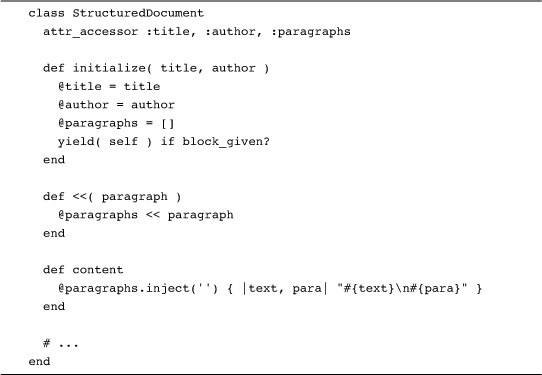
The new StructuredDocument class is mostly just a collection of paragraphs, where each paragraph consists of some text, a font name (i.e., :arial), a font size (perhaps 12 point), and an emphasis, something like :bold or :italic. Thus we might create a resume like this:1

Armed with the newfound power of the StructuredDocument class, we can build all sorts of specialized documents, everything from resumes to instructions for installing an LCD TV.
Subclassing Is (Sometimes) Hard to Do
The trouble is, all that building is going to be real work and, because most resumes and instruction manuals look more or less alike, fairly repetitious work at that. If our users are creating a lot of documents, we might want to help them along. Easy enough. We simply cook up a number of subclasses, each with some helpful methods. We might, for instance, create a subclass for resumes:
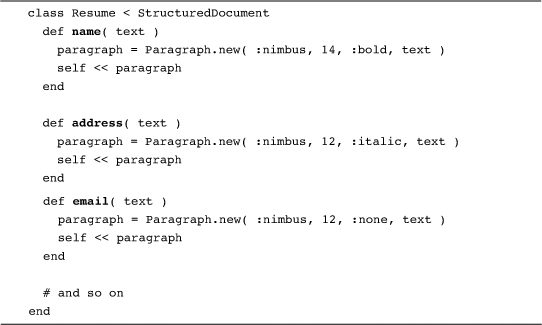
Using these methods, you can programmically build a resume with a minimum of fuss:

You might also do something similar with installation instructions:
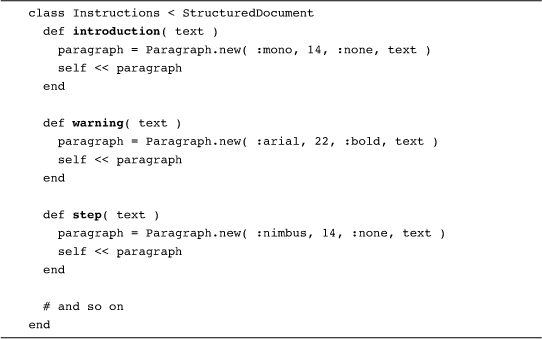
If we step back and look at our handiwork so far, we can see that it’s a bit of a mixed bag. On the plus side, we have built a couple of friendly, user-oriented classes. If you need to build a resume or a set of instructions, we have a handy class that will help you out. The problem is that we still have a lot of repetitive code. Every one of our helper methods looks almost exactly like every other helper method. The method that adds an e-mail address to a resume is, plus or minus a font name and size, identical to the one that adds a warning to a set of instructions. Sadly, there seems to be no cure for this: If we want all those nice helper methods, we simply need to sit down and build them, right?
Class Methods That Build Instance Methods
Perhaps not. Armed with the knowledge that (a) you can change any Ruby class at any time, and (b) Ruby classes definitions are executed, we might just be able to avoid all of this redundant code. The effect we’re looking for is to be able to say, “The Instruction class needs to have a method called introduction that will add a new paragraph rendered in the italic version of Arial at a glorious 18 points” and have Ruby create the method for you. Something like this:

Let’s try to make paragraph_type a reality, one step at a time. First, since we are calling it right inside the class definition, it’s clear that paragraph_type needs to be a class method:

The paragraph_type class method takes two arguments: the name of the new paragraph type (which is also going to be the name of the method we’re going to add to the class) and a hash of options, one that will contain things like the font name and size. The real question is, what do we do inside of the paragraph_type class method? The answer is that we need to define a new instance method on the subclass of StructuredDocument that is calling the paragraph_type method. Your natural impulse is to write something like this:

Unfortunately that is not going to work. The trouble with the familiar def statement is that we have the name of the method we’re trying to create in the name parameter but def requires an explicit “you type it right here” name for the method. In other words, we have the name of the new method as data, but def wants it as code.
The way around this roadblock is to make use of class_eval. Built into all Ruby classes, the class_eval method takes a string and evaluates it as if it were code that appeared in the class body. This is exactly what we need: We’ll just build a string that contains the code for the new method definition and then class_eval the new method into reality:
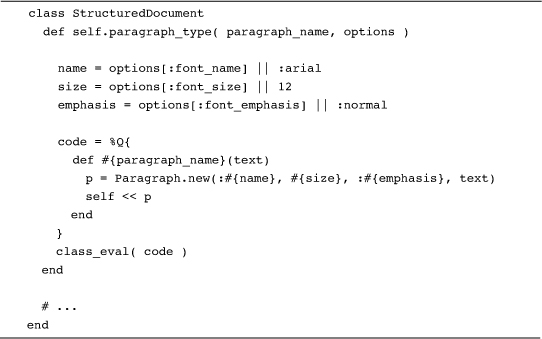
To step through the code shown, imagine that we have this call to paragraph_type:

The paragraph_type method starts by pulling the font name, size, and emphasis out of the options hash, filling in defaults as needed. Now for the interesting part: The paragraph_type method creates a string that contains the code for the new introduction instance method, a string that will look something like this:

Finally, paragraph_type uses class_eval to execute the string, which creates the introduction method. Note that the new method ends up on the StructuredDocument subclass (i.e., Instructions) and not on the StructuredDocument class itself because the whole process started with a call from inside the Instructions class, which set self to Instructions.
Better Method Creation with define_method
Although creating new methods by class_eval’ing a string has a certain clarity to it—if nothing else, you can print out the string and actually see the method that you’re defining—it is really not ideal. We generally like to avoid “evaluate some code on the fly”-type methods if there is a more normal API alternative. In the case of defining a new method, there definitely is an alternative, one with the very obvious name of define_method. To use define_method, you call it with the name of the new method and a block. You end up with a new method with the given name that will execute the block when called. Conveniently, the parameters of the block become the parameters of the new method. Thus, we can reformulate paragraph_type using define_method very easily:
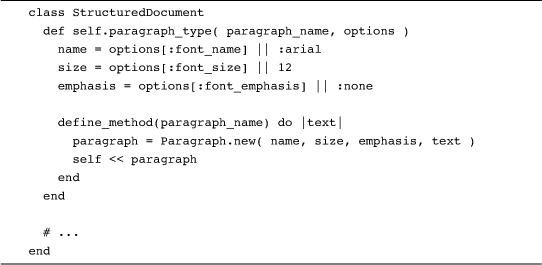
Either way you do it, you end up with a method in the superclass that can add methods to its subclasses. You also have a very powerful technique for creating custom subclasses with very little effort.
The Modification Sky Is the Limit
So far we have only been talking about writing classes that can hang new methods on their subclasses. Once you have the basic idea down, however, there is no limit to what you can do to a subclass from a superclass method. You might, for example, add a method that changes the visibility of the document methods in a subclass:
The thing to note about this code is that it doesn’t change the accessibility of the content method on all StructuredDocument instances. But it does give its subclasses an easy way of declaring the content method private:

Now if you try to get at the contents of a BankStatement:

You are in for a shock:
private method `content' called for #<BankStatement:0x8b8f544>
Nor are you limited to just messing with instance methods. You might, for example, want to mark any document that you privatize with a class method to announce that the document is confidential:

This code starts by defining a default disclaimer method on the StructuredDocument class, a method that proclaims the availability of the document. If you create a StructuredDocument subclass and don’t call privatize, this is the method you will get. If, on the other hand, you do call privatize from your subclass:

Then BankStatement will end up with its own version of the disclaimer method, so that running:
puts BankStatement.disclaimer
Will give you this:
This document is a deep, dark secret
Remember, if you can do it to a class, you can do it from the superclass!
In the Wild
Once you know what to look for, it’s hard to miss Ruby subclass-changing methods in real-world code. In fact, some are built into every Ruby class that you’ve ever written. These ubiquitous methods go by the name attr_accessor, attr_reader, and attr_writer. Think about what attr_accessor and friends do: They let you describe some methods that you want, so that if you say this:

You really end up with a class that looks something like this:

If you have read this far into this chapter, figuring out how attr_accessor and friends works is not hard. Here’s a simple version of attr_reader2 that uses class_eval:

Similarly, here’s a stripped-down version of attr_writer, this time using define_method:

Aside from attr_accessor et al., the most well-known subclass changing methods are probably those that come with ActiveRecord. As every Rails programmer knows, doing this:

Means that you can say my_car.manufacturer to get to the object that represents the company that made the car.
Finally, if you look in forwardable.rb, which is part of the Ruby standard library, you will find still more examples of class-modifying methods. The idea behind forwardable.rb is similar to delegate.rb, which we met when we were talking about using method_missing to delegate. Both of these library classes try to make delegation easy. The difference is that where delegate.rb takes the method_missing approach to delegation, catching calls to nonexistent methods and sending them off to the other object, Forwardable actually generates the delegating methods on the fly.
The interesting thing about Forwardable is that it’s not a class at all. It’s a module that you mix in at the class level with extend. Other than its slightly surprising packaging, Forwardable works exactly like the examples in this chapter. Here, for instance, is a simple class that looks like a document, but that actually just bounces all the method calls to title, author, and content off to a real Document instance:
Like our earlier delegate.rb-based DocumentWrapper, this one lets you treat the wrapper just like the original:

Here is an edited version of the key method in Forwardable:

Aside from the fact that this code uses module_eval—which is synonymous with class_eval—this is exactly the string-based technique that we've been discussing.
Staying Out of Trouble
It’s easy to get lost when you first try to do the sort of metaprogramming we looked at in this chapter. The problem is not that this is an extremely complex process; it’s just that most programmers new to Ruby are not used to thinking in terms of modifying classes at all, let alone writing methods to do the modification for them, let alone moving those methods up to a superclass. If you feel like this technique has left you in a confusing maze of twisty passages,3 here are some signposts that can help.
First, keep your goal firmly in mind. In our example, we wanted to make it easy to add paragraph-generating methods to StructuredDocument subclasses.
Second, know when things happen. For example, when you load the StructuredDocument code, perhaps with this:
require 'structured_document'
You end up with the generic StructuredDocument class, which has the paragraph_type class method on it. A bit later (perhaps even on the very next line of code) you load the Instructions class:
require 'instructions'
As the Instructions class definition is getting executed, it will fire off calls to the paragraph_type method up in the StructuredDocument class. This will add methods with names like introduction, warning, and step to the Instructions class. Only when all of this defining is over do you make an instance of Instructions and call the generated methods.
The third thing to know is that the value of self is at every stage of this process. This starts out relatively straightforward but gets a little hairy as you go along. The straightforward bit is in the superclass:

When you say def self.paragraph_type, you are defining a new class method on the StructuredDocument class. But—and this is a key “but”—when you call the paragraph_type method from the subclass, self will be whatever class called the method. Thus, self inside paragraph_type will be Resume or Instructions (the subclass), not StructuredDocument. This is why the introduction method ends up on Instructions and not on StructuredDocument.
Finally, when you actually call the generated method on an instance of your subclass, maybe like this:

The value of self inside the generated method will be the Instructions instance. As the philosophers say, “Know thyself”!
There is one other thing to beware of with the metaprogramming techniques we’ve covered in the past few chapters—the inclination of programmers to either avoid them completely or use them for everything in sight. So the question is: When should you pull out the metaprogramming and when should you stick to garden-variety code?
As usual, the extreme cases are the easiest. If you can solve your problem in a reasonable way with your traditional programming chops, do that. Do you need to share the same method between several different classes? You could add that method on the fly to both classes, but probably you are better off putting the method in a superclass or a mixin module. In the quest for software that is actually useful, simple solutions to straightforward problems have a plain eloquence all their own.
At the other extreme are the things you just cannot do without metaprogramming. If you need to build a generic method-agnostic proxy or a reloadable Document class, metaprogramming is the only solution.
The intermediate cases, problems like our “to encrypt or not to encrypt?” question and the Ruby 1.8/1.9 incompatibility handler are harder. If you can solve a problem with some traditional code or a touch of metaprogramming, how do you decide? Again, it’s all about striking a balance. Metaprogramming can dramatically reduce the volume and the complexity of your code. Hooks let you define code that will run at helpful times. Method missing and the techniques that rely on open classes can save you an enormous amount of coding toil. All of this, however, comes at a price. Those hooks might go off at unexpected times. Using method missing and open classes means that your application will be running code that has no obvious counterpart in your source tree.
The trick is to simply get back more programming goodness than you pay in meta-complexity. Take the Ruby 1.8/1.9 string example that we looked at in the last chapter. In real life, would I actually use class-level logic to deal with that one problem? Probably not. In real life I would probably code some ordinary run-time logic that asked itself about the Ruby version and did the right thing. If, however, I was doing this with scores of methods, or if the this or that logic was complex, I might well turn to metaprogramming. The bottom line is simple: Make that metaprogramming pay for itself.
Wrapping Up
The trouble with traditional programming languages is that they treat classes as if they were petrified. You make a class and there it is, eternal and unchanging. As we have seen in the last few chapters, the Ruby way of looking at things is that classes are objects just like any other. If you are somehow unhappy with the contents of your class, you can change them. Two chapters ago we saw how you can change Ruby classes manually, via monkey patching. In the last chapter we saw how you can write classes that reconfigure themselves. Finally, in this chapter we saw how you can share all of that class-changing logic by moving it into a superclass or a module.
One of the advantages of metaprogramming is the way you can use it to give your Ruby a customized “made just for this problem” feel. Page back and look at the examples in this chapter. One thing that stands out is how the paragraph_type and privatize methods feel less like methods and more like key words, specialized parts of a new Ruby-like language. Now there’s an idea worth pursuing.



